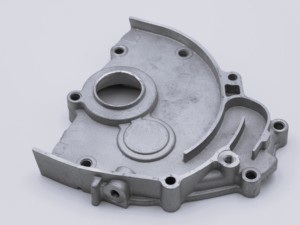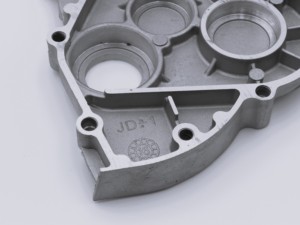
All categories
Featured selections
Trade Assurance
Buyer Central
Help Center
Get the app
Become a supplier

(998 products available)














































Typically, the fabric used for an aluminum die casting engine cover varies from aluminum and zinc alloys to magnesium and copper alloys.
Aluminum alloys
Aluminum is typically preferred for die casting due to its high strength-to-weight ratio. In addition, 356 aluminum alloy, which comes with silicon and magnesium, enhances fluidity and reduces shrinkage. Typically, this makes it ideal for complex engine cover shapes. Also, the 380 alloy provides excellent castability and corrosion resistance. Often, it is used in automotive parts exposed to harsh environments.
Zinc alloys
Occasionally, zinc alloys like ZA-8 and ZA-12 come with high wear resistance and are ideal for external applications. Also, they can be combined with aluminum to create a lightweight engine engine cover that still maintains durability. Still, their ability to be easily plated or painted enhances their aesthetic and functional value.
Magnesium alloys
Normally, magnesium alloys are lightweight, thus reducing the overall weight of the vehicle. However, they are less commonly used in die casting due to higher costs. Nonetheless, structures like these are ideal for high-performance vehicles where every gram matters.
Copper alloys
Occasionally, copper-based alloys, although expensive, are sometimes integrated into die casting for components requiring superior thermal conductivity. Also, the skill 632 bronze, which comes with excellent corrosion resistance, provides an option for high-performance environments.
Usually, an aluminum die-casting engine cover constitutes several uses ranging from protecting vital engine components to enhancing an automobile’s aesthetics.
Protection
Usually, an engine cover plays a critical role of safeguarding engine components. Normally, it shields parts like the camshaft, timing belt, and ignition system from dirt, debris, and fluid leaks. Ideally, this prevents contamination and reduces the risk of damage, ensuring optimal performance. In addition, the cover also protects sensitive components from heat generated during engine operation. Normally, this maintains their integrity and extends their lifespan, especially in high-performance environments.
Heat dissipation
Often, aluminum’s excellent heat conductivity allows the engine cover to disperse excess heat generated by the engine. Ideally, this aids in keeping the engine at a stable operating temperature. This is, therefore, helpful in preventing overheating and ensuring efficient engine operation. Also, effective heat dissipation is vital in maintaining performance during extended periods of driving or under heavy loads.
Aesthetic appeal
Normally, the engine cover is produced to provide a polished look of the engine bay. Also, this enhances the overall aesthetic appeal of the vehicle. Usually, manufacturers design covers with sleek finishes and logos that reflect the car’s brand and style. This creates a more visually appealing engine compartment. Usually, this is particularly important for luxury and high-end vehicles. Their target consumer is, mainly, photographic enthusiast and potential buyers.
Noise reduction
Customarily, modern engine covers are designed to minimize noise generated by the engine. Ideally, soundproofing materials are integrated within the cover. Therefore, it helps to dampen vibrations. Usually, this contributes to a quieter ride. In addition, reduced engine noise is essential for providing passenger comfort. More importantly, it enhances the overall driving experience.
Supporting structure
The engine cover is normally mounted to the engine block. Therefore, it provides support to other components of the vehicle. Also, it helps in maintaining proper alignment and stability. In addition, some covers are designed to accommodate accessories. These include intake systems or wiring harnesses, thus integrating into the vehicle’s overall structure and functionality.
Usually, customization for an aluminum die-casting engine cover includes options from design and finish to functional modifications.
Design and shape
Usually, custom die casting allows for intricate designs. Therefore, the aluminium engine cover can be tailored to fit specific engine configurations perfectly. This precision enables not only unique shapes but also incorporation of brand logos or custom patterns. This enhances aesthetic appeal and brand representation further.
Material thickness and accents
Ideally, customization with varying material thickness helps in adjusting the weight and durability of the engine cover. More often than not, a thinner design enhances flexibility and ease of installation. In contrast, a thicker build enhances strength and wear resistance. Besides, custom accents like ventilation slots, raised elements, or embossed logos can enhance functionality and style.
Surface finish options
Normally, die-cast aluminum can be finished in various ways. These include anodizing, powder coating, or chrome plating. Anodizing adds a protective layer that comes in assorted colors. Usually, it is available for corrosion resistance and aesthetic purposes. Also, powder coating provides a durable, vibrant finish that is weather resistant. This enhances the cover’s visual appeal. Moreover, chrome plating adds a reflective surface. Commonly, it provides oxidation protection and a sleek look.
Functional features
Customarily, an aluminum die casting enables addition of features like integrated mounting points or heat sinks. Usually, these modifications improve the cover’s functionality. Therefore, it provides better support during installation or aids in heat dissipation. Also, customization options include slots for better airflow or cable management pathways. This helps in maintaining the engine at optimal temperatures and keeps a tidy appearance.
Fit and branding
Customarily, a die cast prototype allows for the creation of covers that fit specific engine layouts with precision. Also, it ensures compatibility with various engine components. In addition, this presents an opportunity for brand promotion. Often, covers can be inscribed with custom designs or logos. This makes the cover a billboard for promotional activities in automotive events.
Usually, when selecting an engine cover, it is vital to consider aspects like material and quality to compatibility and customization.
Material and quality
Die-cast aluminum is usually preferred for its strength, lightweight nature, and resistance to corrosion. Therefore, when purchasing, choose high-quality aluminum alloy covers that will offer durability as a barrier to harsh engine conditions. Also, the quality can be determined by checking user reviews and convening with the manufacturer for certification.
Compatibility
Often, ensure the cover is compatible with the specific engine model, especially if driving different vehicles. Getting a cover tailored for a specific engine ensures easy fitment and proper functioning. Ideally, manufacturers often provide lists of compatible models. Therefore, refer to them when choosing the cover.
Design and functionality
Usually, consider the design of the cover. Ideally, prefer one with features such as ventilation that aid in heat dissipation. These features enhance airflow, thus preventing overheating. Further, a model of the engine cover with integrated oil separators or dampeners provides additional functionality. They reduce noise and unwanted vibrations.
Branding and customization
Cater to personal preferences by choosing an engine cover that can be custom branded or designed. Normally, having a custom cover with unique designs or branded logos enables one to have a unique vehicle. This also promotes the brand during events and meetups. Therefore, select manufacturers who offer customization options.
Budget
Customarily, engine covers are available in priced differently. Usually, the price depends on quality, material, and brand. Therefore, establish a budget before shopping. This helps in narrowing down choices. Also, consider the long-term value. More importantly, investing in a quality cover that makes a vehicle more durable is more beneficial in the long run.
Usually, multiple factors such as quality finish, thickness, and alloy type define the durability of an aluminum die cast engine cover. Often, quality aluminum alloys like 356 offer superior strength and corrosion resistance. This enhances durability. Also, a good cover is normally manufactured with optimal thickness. Therefore, a thicker cover comes with better durability and more protection against external elements. On the other hand, a thinner cover is lightweight. Additionally, a die-cast cover with a corrosion-resistant surface extends its lifespan. Moreover, exposure to moisture leads to corrosion.
Customarily, surface finish impacts aspect and functionality equally. For instance, anodizing enhances corrosion resistance. Usually, it is a standard for die-cast aluminum. Chrome plating frequently protects from corrosion; thus, improving aesthetics. Typically, a smooth finish decreases friction. This makes it easier to install components and enhances heat dissipation within the engine, improving overall performance.
Common customization options for aluminum die-casting engine covers normally include integration of brand logos, unique designs, and functional features. Usually, businesses add custom logos to promote their brand. At the same time, they actively participate in automobile events. Also, manufacturers occasionally incorporate features like ventilation slots or cable management pathways. Normally, these modifications enhance the cover's aesthetic appeal while improving its functionality.
Commonly, the standard signs of warping on an aluminum die-casting engine cover come in the form of misalignment, unusual noises, and difficulty in securing or removing fasteners. Normally, warping causes the cover to misalign with the engine. As a result, there will be gaps between the cover and engine components. This would, therefore, lead to rattling or vibrating. Also, warping adversely affects the mounting points. Normally, they may become uneven or loosened. Therefore, it becomes difficult to secure the cover properly.